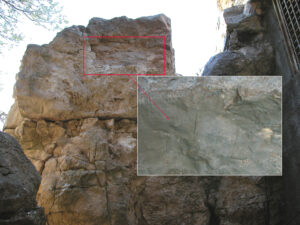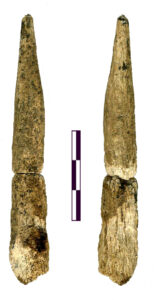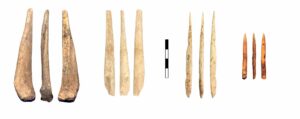We enter the cave
At the mouth of the present entrance, on the upper left wall, there are engravings in the form of deep indentations and straight or curved lines, possibly stylised figures of symbolic value. They date back to around 18,000 years ago.

Two steps and we are in the first room, the ‘atrium’:

is the site of systematic excavations that began in 1961 and have revealed (so far) a stratigraphy of 12 metres (levels 1-30).

It is thanks to this stratigraphic sequence that Paglicci is recognised as one of the most important Palaeolithic sites in Europe. Above the Middle Palaeolithic levels, the series covers the entire Upper Palaeolithic time span, allowing us to reconstruct the climatic and cultural evolution of 30,000 years of practically uninterrupted Prehistory.
MIDDLE PALAEOLITHIC

Layers 30-29:
these are the oldest, investigated very marginally, and correspond to levels 4-3 of the survey in the outer area, an ancient hall now open to the sky: we are around 250-200 thousand years ago, within the early phase of the Middle Palaeolithic, the era of Neanderthal Man. The fauna of these latter levels indicates an arid continental climate and a steppe landscape, transitioning at the top to grassland.
The lithic industry fits into the Acheulean technocomplex, and is characterised by the production of small tools alongside some bifaces.

The bifacial is, we might say, the most popular Palaeolithic tool in the collective imagination: it is rather large, retouched on both faces to obtain a shape generally almond-shaped (‘amygdala’ from the Greek) with lateral shears, a point and a part suitable for gripping opposite the point. In Apulia, the discovery of bifaces is frequent, especially in the Gargano area, in surface collections.

Layers 28-26:
correspond to level 2 of the exterior. We are still in the ancient phase of the Middle Palaeolithic, about 150,000 years ago. The chemism of the soil destroyed much of the fauna and even the stones. From the few identifiable remains, we can assume a wet temperate period. Lithic production changed and aimed at obtaining rather large and thick chips, with retouching repeated several times on the same piece, perhaps to resharpen the cutting edge as it wore down (the so-called Quina retouch from the French site of the same name).


Layer 25:
barren, probably connectable to layer 1 of the outer survey, when the ceiling of the hall collapses, human frequentation becomes sporadic and it is rather the hyena that establishes its lair among the boulders.
UPPER PALAEOLITHIC

Layer 24:
after an abandonment of around 100,000 years, man returned to the cave 40,000 years ago: now it is groups of Homo sapiens who will continue to establish their temporary camps until 13,000 years ago.
The oldest techno-complex is the Aurignacian: the climate is dry temperate, the lithic industry is characterised by the production of lamellae, which can be marginally retouched and are straight in the lower levels, ‘crooked’ in the upper levels. A bone awl is present.


Layers 23-18B:
constitute the Gravettian series, a complex that developed between 30-25 thousand years ago and evolved in three phases (ancient, evolved and final). The climate is overall colder than the present day, sometimes intensely cold, emphasised by the presence of the marmot (evolved phase, layers 21-20) and the prevalence, among ungulates, of ibex and horses.

Layers 20 to 21:
The lithic production is characterised by the deep-backed points, which were placed in series on shafts to form a composite arrow used in hunting activity: the use of a bow or propeller is therefore probable.
On the other hand, other artefacts were used in domestic activities, both lithic and bone, the latter consisting of points/points made mainly from horse bones.


Layer 23:
From these levels come truly exceptional finds (in chronological order):
in the ancient phase, a sandstone millstone that has preserved some starches, including wild oats, a rare testimony to the harvesting and food use of vegetables, transformed into flour;


Layers 22 to 21:
at the ancient/evolved phase transition, two burials, of an adolescent girl (12-13 years old) the oldest (PAII, roof layer 22), of a young woman (18-20 years old) the most recent (PAIII, base layer 21A). Both are sprinkled with ochre with artefacts and ornaments;

Layer 20:
in the evolved phase, the oldest piece of movable art on the site, an aurochs femur on which is engraved the profile of an ibex overlaid with a series of geometric features and motifs (Layer 20C).


Layer 18A-3:
these are the strata of the Epigravettian, also subdivided into three phases (ancient-evolved-final) datable between 25-13 thousand years ago. The climate, still cold in the first two phases, turns temperate in the final phase, with the appearance, among ungulates, of forest species such as deer and wild boar.
The lithic industry sees, in the ancient phase, the presence of deep-backed points with a cran to facilitate the insertion of the shaft.

In the later phases, this element disappears, and the backs gradually tend to become microlithic with the appearance of geometric shapes (half-moons, triangles). In the industry on bone, thin Gravettian awls (next figure on the left) are rarefied, spear points appear (next figure on the right) and, only in the early phase, artefacts in stagstones.

These levels are also characterised by the exceptional nature of the finds:
In the ancient (and later) phase, dog remains have been found, among the oldest in Europe, demonstrating an early domestication of the wolf: the dog, this precious friend, has thus been our faithful companion for 20,000 years!


Layer 14:
A limestone slab with, painted, the rear train of a running horse belongs to this phase (layer 14); it presumably collapsed from the ceiling where the entire figure may have been part of a frieze that has unfortunately been lost. It is surprising how the style and chronology (around 19,000 years) coincide with those of some paintings in the famous Lascaux cave in France.


Layers 8 to 9:
From layers 9-8 (dating from around 18,000 years ago) of the evolved phase come a number of movable artworks, animal subjects, but also geometric motifs, engraved on bone, pebble or stone. Aurochs heads, as well as birds and naturalistic ‘pictures’ (a nest undermined by a snake).
|
|
The hunting scene depicting a horse, flanked prospectively by two deer, fleeing pursued by a swarm of soaring arrows is remarkable; the liveliness and dynamism of this scene contrasts with the depiction, on another support, of a horse struck by darts and dying.
|
|

Works of art, although rarer, were found in the final phase. Of certain importance is the discovery of a partial burial (lower part of the body), which unfortunately took place during the first years of excavation and is undocumented (layer 5base, dating to around 15,000 years ago). Also from the same layer is a limestone slab on which rested two humeruses belonging to two individuals of different ages: a kind of shrine suggesting a sort of ‘relic’ collection.

Here, this amazing series comes to an end due to the collapse of part of the ceiling that prevented human groups from entering the cave until fairly recent times.
From the atrium, continuing the tour, one can descend, by crawling through a low passage, to Room 1 and, via a tunnel artificially dug into the deposit by the underground, to Room 2, both of which have sporadic traces of Palaeolithic frequentation and are in communication with each other through a narrow passage.

Room 1 is accessed from room 3, the hall of paintings, via a narrow, artificially excavated corner corridor: originally, the fill reached about 30 cm from the ceiling, effectively obstructing the entrance to the hall of paintings.

The currently clearly visible paintings, located at the back of the cave in a room that, as mentioned, is not easily accessible, include two horses, one of which is upright, and a series of hands.
Their great importance lies in being the ONLY proven example of Palaeolithic wall paintings in Italy and in their antiquity: they probably date back to the Gravettian period.
Here, with the exceptional encounter with the symbolic world of these ancestral peoples, our visit to Grotta Paglicci comes to an end. All that remains is for us to go back and see the light of day again…














